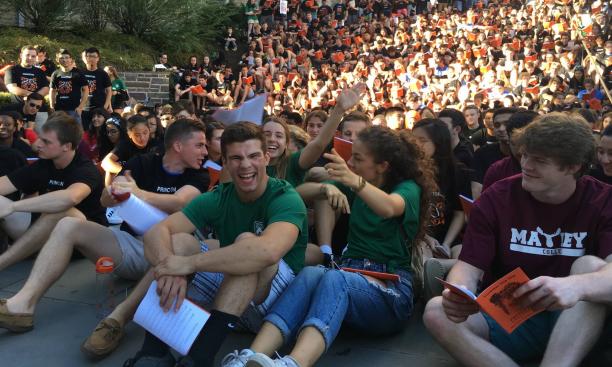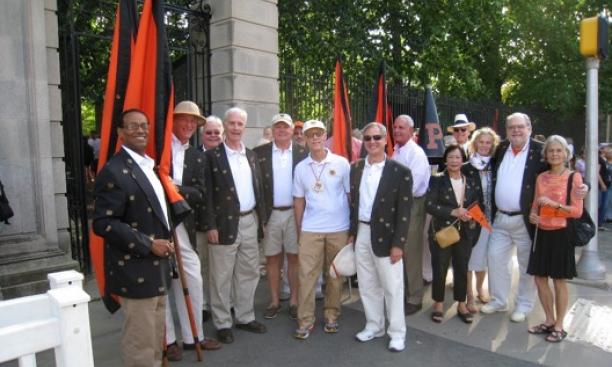
If I ever go looking for my heart’s desire again, I won’t look any further than my own front campus. Because if it isn’t there, I never really lost it to begin with.
— With apologies to Dorothy Gale, The Wizard of Oz, 1939
As I mentioned in a recent Goin’ Backstory podcast, I already have seething, unbridled envy for the Class of 2020, otherwise known as my “grandchild class.” It goes far beyond their being a bit younger than I, although that certainly provides a robust start, but extends mainly to the built-in marketing advantages they can revel in for the rest of their days, starting with the obvious orange “2020” oversize eyeglasses and including multifarious eye charts all the way to instant classic bumper stickers:

Anybody who tries to tell you life is fair, just ask the Class of 2019. Of course, they do have prime factors of 3 and 673 to work with, but still ...
Anyway, 1970, the University’s very first grandparent class — we have nine alumnae, the first in undergraduate history — as opposed to grandfather class, gamely marched ahead of the lucky youngsters in the September Pre-rade, a recent wrinkle on old traditions you wouldn’t know if you graduated prior to 2004. That’s when the Princetoniana Committee, in one of its grumpy moods (i.e. we were awake), decided the undergrads were not exuding sufficient esprit and knowledge of college history, and inveigled the administrative powers to create the Pre-rade and freshman step sing to indoctrinate the unsuspecting newbies.

Hey, it works, don’t knock it ’til you’ve tried it. Starting with a pre-existing commitment (the Sunday Opening Exercises in the Chapel) the freshmen march, college by college, behind the begowned faculty and their grandparent and parent classes, then in through FitzRandolph Gate, whence they’ll exit after their Commencement four years hence to face the New Jersey traffic on Nassau Street. Then they follow the same route they’ll take leading the P-rade in 2045 — wow, that went fast! — and head past West College to Alexander Beach. There they have a picnic and head down the Blair Arch steps, get their new class T-shirts, and engage in learning some Princeton songs (“Goin’ Back,” “The Cannon Song,” you know the drill), interspersed with pop stuff: Justin Timberlake, Sia, and — every year for some reason — Journey’s “Don’t Stop Believin’,” which was written before they were born. All this leads up to two crucial milestones: first, lovingly detailed instruction in the Princeton locomotive from the irrepressible Tom Meeker ’56, who inherited the task from his classmate Bob Rodgers ’56, the great Princetoniana leader who initiated the Pre-rade activities in 2004; then, the Class of 2020’s first run-through of “Old Nassau,” with the attending alums ostentatiously demonstrating the arm motions for the chorus, which no one this young would ever associate with a beer stein. Never. Nope.
After a few years of this now, I must say that, if anything, I’m intrigued by the virtually universal enthusiasm the freshmen have for this rather corny exercise in pep-rally-ism, when they could be back at their college tweeting mom about how their new roommate has just received rave notices from The New York Review of Books for a definitive tome on Euclid’s applicability to the Riemann hypothesis, and how things appear somewhat less bucolic in New Jersey than the “Garden State” label might imply. Actually, that answers my question, I guess. But imagine how much more they’d enjoy the Pre-rade if they had the time to study up beforehand on the stories behind their 10-minute saunter through the front campus. When you stop to consider it, it must be one of the great short history strolls in North America. You have:
- Coming out the West Door of the Chapel onto Firestone Plaza, all the principals in the Last Great Face-off between church and state at Princeton. East Pyne in front of you, which opened as the Pyne Library in 1897, was the academic foundation for the newly renamed University, but Woodrow Wilson 1879’s academic reforms in the next decade put severe pressure on it, and by 1920 the new Graduate School and undergrad independent work had packed it to overflowing. Then the beautiful Marquand Chapel burned in 1920, and the trustees and President John Grier Hibben 1882 *1893 faced a choice. Hibben, the last of the Presbyterian clergy presidents, oversaw every detail of the funding, design, and construction of the new University Chapel, the second largest in the world, which opened in 1928. Then came the turmoil of the Great Depression and World War II, and so Firestone Library to your right finally opened to replace the overwhelmed Pyne … in 1948.
- Heading toward the east arch of East Pyne, the statue of John Witherspoon (actually the twin of one in his native Scotland) details the unique combination of skills, even among America’s founding fathers, of this cleric/scholar/patriot and signer of the Declaration of Independence.
- Going through the west arch of East Pyne, the site of the infamous “Crime of ’96,” the construction by the trustees under Moses Taylor Pyne 1877 of the new Pyne Library on the torn-down remains of East College, a twin to West College and dorm beloved of generations of students, ironically including both Pyne and his brother.
- Emerging from East Pyne onto Cannon Green, scene of football bonfires and senior Class Day with its buried British cannon (secured there against Rutgers ruffians, not soldiers) and the ivied walls of Nassau Hall. This is the side that faced the American attack in the pivotal Battle of Princeton in 1777 and still bears marks of the cannon fire, not to mention dozens of plantings of class ivy and their marking stones.
- Heading north toward Nassau Street, passing the Sept. 11 Memorial Garden where the 14 Princetonians who died that day are memorialized. Coincidentally, this year the Pre-rade took place on Sept. 11; the memorial service was at noon, and the flowers there were still fresh when the freshmen passed by at 4 p.m.
- A few steps farther north, passing the peripatetic Joseph Henry House, built in 1837 by its namesake, the professor and foremost American scientist of the 19th century, continuing symbol of Princeton’s regard for the hard sciences. Built where Henry Moore’s Oval with Points now resides, it moved for construction in 1879 to the site of the Chapel, in 1925 to the site of Firestone, and in 1946 to its current location across the campus from Maclean House.
- Entering the front campus from Nassau Street, the walk through FitzRandolph Gate, which since 1905 has honored the original donor of the land for the College in 1756. Once kept closed and locked except for Commencement, Reunions, and ceremonial occasions, it was opened permanently as a gesture of openness and community upon the petition of the senior class of 1970. When the Class of 2020 exits there at its Commencement, the gateway will have been open for 50 years.
- Walking through the greensward of the campus. Not “a” campus but the original campus, a term for a college yard initiated by Latin scholar Witherspoon himself (it means “field”) upon seeing the relatively large spaces occupied by college grounds in America when he arrived in 1768. In use here since the 1770s, the term only became common elsewhere in America after the Civil War. The site of Princeton’s most important occasions, its stateliest elms and limitless black squirrels and, every 17 years, brood X cicadae.
- Continuing straight ahead to Nassau Hall itself, constructed of local materials 260 years ago. A model since for countless college anchor buildings (often known as “Old Main” or some such), it is the site of the first great victory of the American Revolution, temporary capitol of the new country in 1783, and an iconic symbol of the University to the outside world. It contains many of Princeton’s most sacred spaces, including the memorial hall to those who have died in America’s wars, as well as the Faculty Room that was opened in 1905, and the office of the president.
- Passing Stanhope Hall, the first “library” built as such, in 1803, and the first dedicated academic building on campus. Intriguingly, every building ever used as a main library since 1756 at Princeton still stands — Nassau Hall, Stanhope, Chancellor Green, East Pyne, and Firestone.
- Cavorting alongside Henry Moore’s patinated bronze sculpture Oval with Points. Always a crucial juncture on any Frisbee golf course, almost as importantly it is one of the linchpins of the Putnam collection of outdoor sculpture, which in the last 50 years has transformed the campus into one of the great art spaces in the Western Hemisphere. Dozens of renowned artists are represented, many by major works including a gigantic concrete Picasso.
And thence, on to building a better burger. Dei sub numine salsa.
